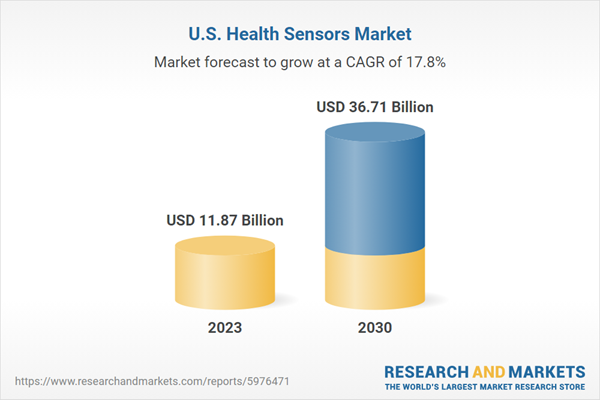The adoption of health sensors among individuals looking to monitor their health proactively is also increasing due to the growing focus on preventive healthcare and wellness initiatives. For instance, in January 2024, Medtronic launched the MiniMed 780G system alongside Simplera Sync after securing CE Mark approval. This system unveils an all-in-one continuous glucose monitor (CGM), eliminating the requirement for fingersticks or overtape while delivering an upgraded user experience with a simplified two-step insertion process and smaller size, half the dimensions of earlier Medtronic sensors.
Technological advancements in sensor technologies, including miniaturization, improved accuracy, and connectivity features, make health sensors more accessible and user-friendly. This has led to the development of wearable health devices that can track vital signs, activity levels, and other health metrics in real-time. Government initiatives and regulations promoting digital health technologies, including health sensors, have also played a crucial role in driving market growth.
Policies that support the integration of sensor-based solutions into healthcare systems have facilitated greater adoption and acceptance of these technologies. The Office of the National Coordinator for Health Information Technology (ONC), under the U.S. Department of Health and Human Services, plays a pivotal role in promoting the use of health information technology (IT) and digital health technologies. The ONC has established various programs and initiatives, such as the Health IT Certification Program and the Interoperability and Patient Access Final Rule, which encourage the development and adoption of interoperable health IT systems, including those incorporating health sensors. These efforts aim to improve the quality, safety, and efficiency of healthcare delivery while protecting patients’ privacy and security.
U.S. Health Sensors Market Report Highlights
- Wearable sensors segment held a substantial revenue share of 35.1% in 2023. This is attributed to several factors, including increasing demand for health & fitness trackers, growing popularity of smartwatches & other wearable devices, rapid advancements in technology & miniaturization of electronic components, and increasing availability of wireless communication technologies
- Chronic illness and at risk monitoring application dominated the market in 2023 with a share of 30.8% owing to the shift towards value-based care models and the emphasis on preventive healthcare. Healthcare providers are increasingly focusing on proactive interventions and early detection of health issues to reduce healthcare costs and improve patient outcomes. By leveraging remote monitoring solutions, healthcare organizations identify high-risk patients, track their health metrics remotely, and intervene promptly when necessary, leading to better disease management and reduced hospitalizations.
- In April 2024, Koninklijke Philips N.V., a global healthcare company, and Northwell Health, one of the largest healthcare providers in the U.S., forged a seven-year partnership to standardize patient monitoring, elevate patient care, and enhance outcomes, all while promoting interoperability and fostering data innovation.
Table of Contents
Companies Mentioned
- Analog Devices, Inc
- Avago Technologies Ltd.
- Danaher Corporation
- First Sensors AG
- GE Healthcare
- Honeywell International Inc
- Koninklijke Philips N.V.
- Medtronic
- OMNIVISION
- Proteus Digital Health
- Sensirion AG
- Smith’s Medical Inc. (ICU Medical)
Methodology

LOADING...
Table Information
| Report Attribute | Details |
|---|---|
| No. of Pages | 80 |
| Published | May 2024 |
| Forecast Period | 2023 - 2030 |
| Estimated Market Value ( USD | $ 11.87 Billion |
| Forecasted Market Value ( USD | $ 36.71 Billion |
| Compound Annual Growth Rate | 17.8% |
| Regions Covered | United States |
| No. of Companies Mentioned | 12 |









